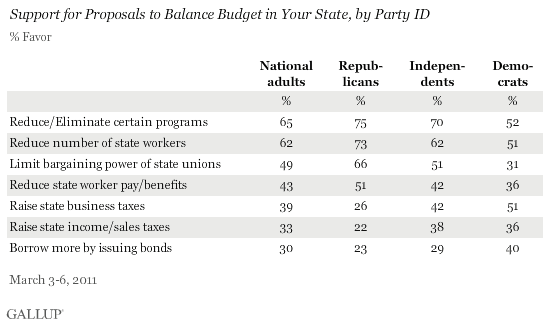PRINCETON, NJ -- Of seven possible ways to balance their own state's budget, Americans are most likely to favor cutting back on state programs (65%) and reducing the number of state workers (62%). Floating more bonds (30%) and raising state income or sales taxes (33%) garner the least support, followed by raising business taxes (39%).

In the nation's most high-profile budget battle, Wisconsin Gov. Scott Walker has portrayed state worker layoffs as the more draconian option he is trying to avoid by proposing cuts to state employees' pay, benefits, and collective bargaining. Nevertheless, more Americans favor layoffs than favor pay and benefit cuts, perhaps because the Gallup question doesn't specify the magnitude of each. While 62% of Americans favor layoffs, fewer than half, 43%, favor cutting state workers' pay and benefits and 54% are opposed.
Additionally, the March 3-6 poll finds Americans closely divided on the primary issue in the Wisconsin budget battle -- whether to "[change] state laws to limit the bargaining power of state employee unions." About half of Americans polled, 49%, say they would favor this in their own state; 45% are opposed.
A late February Gallup poll found 33% of Americans in favor of and 61% opposed to changes to collective bargaining laws when the issue was described as passing a law "that would take away some of the collective bargaining rights of most public unions, including the state teachers' union." Although the timing of the surveys could be a factor, the differing results likely reflect Americans' sensitivity to nuances in how the debate can be framed. They may also indicate the high and low boundaries of support for setting new limits on collective bargaining.
Partisans Agree More Than They Disagree
There is broad partisan agreement on four of the seven proposals tested. Majorities of Republicans and Democrats favor cutting back on state programs and reducing the number of state employees (although support for these is greater among Republicans than among Democrats). Majorities of Republicans and Democrats also oppose raising their state's sales and income taxes and oppose more borrowing as a means to balance the budget -- with Republicans more sharply opposed to both.
By contrast, Republicans and Democrats substantively disagree on the three other proposals. Majorities of Republicans favor limiting the collective bargaining power of state employees and cutting state workers' pay and benefits, while a majority of Democrats are opposed to these measures. Conversely, the majority of Democrats favor raising business taxes, while most Republicans are opposed.
The views of political independents fall closer to Democrats' views on the two tax proposals, but are closer to the Republicans' in terms of cutting state programs, increasing state borrowing, and changing collective bargaining laws.

Shift in Support for Program Cuts Since February
Two of the items contained in the survey -- reducing or eliminating certain state programs and reducing the pay and benefits for state employees -- were measured using a four-point "strongly favor" to "strongly oppose" scale in a separate Feb. 21 Gallup survey. While the overall percentage favoring cuts to worker pay/benefits was fairly constant in both surveys, the total percentage in favor of cutting state programs increased from 47% in February to 65% today. Whether this reflects a real change in Americans' views, or is a result of differences in the scale or number of budget proposals tested in each survey, is unclear. In any case, of the various options tested in both surveys, cutting state programs yielded the least opposition.
Bottom Line
At a time when Americans' confidence in the economy remains depressed, their personal spending remains cautious, and underemployment remains high, they are looking to state governments to dial back spending rather than tax or borrow their way to a balanced budget. However, they have mixed views on the extent to which state workers should be asked to sacrifice. While 62% of Americans are in favor of reducing the number of workers on their state's payroll, far fewer, 43%, favor reducing state workers' pay and benefits.
The good news for lawmakers seeking consensus is that Republicans and Democrats are broadly united in support of cutting programs and reducing state work rolls, and both groups generally oppose raising income and sales taxes as well as borrowing. At the same time, the greatest disagreement is over curtailing collective bargaining, underscoring the difficult nature of the budget impasses in Wisconsin and other states.
Survey Methods
Results for this Gallup poll are based on telephone interviews conducted March 3-6, 2011, with a random sample of 1,021 adults, aged 18 and older, living in the continental U.S., selected using random-digit-dial sampling.
For results based on the total sample of national adults, one can say with 95% confidence that the maximum margin of sampling error is ±4 percentage points.
Interviews are conducted with respondents on landline telephones (for respondents with a landline telephone) and cellular phones (for respondents who are cell phone-only). Each sample includes a minimum quota of 150 cell phone-only respondents and 850 landline respondents, with additional minimum quotas among landline respondents for gender within region. Landline respondents are chosen at random within each household on the basis of which member had the most recent birthday.
Samples are weighted by gender, age, race, education, region, and phone lines. Demographic weighting targets are based on the March 2010 Current Population Survey figures for the aged 18 and older non-institutionalized population living in continental U.S. telephone households. All reported margins of sampling error include the computed design effects for weighting and sample design.
In addition to sampling error, question wording and practical difficulties in conducting surveys can introduce error or bias into the findings of public opinion polls.
View methodology, full question results, and trend data.
For more details on Gallup's polling methodology, visit www.gallup.com.
